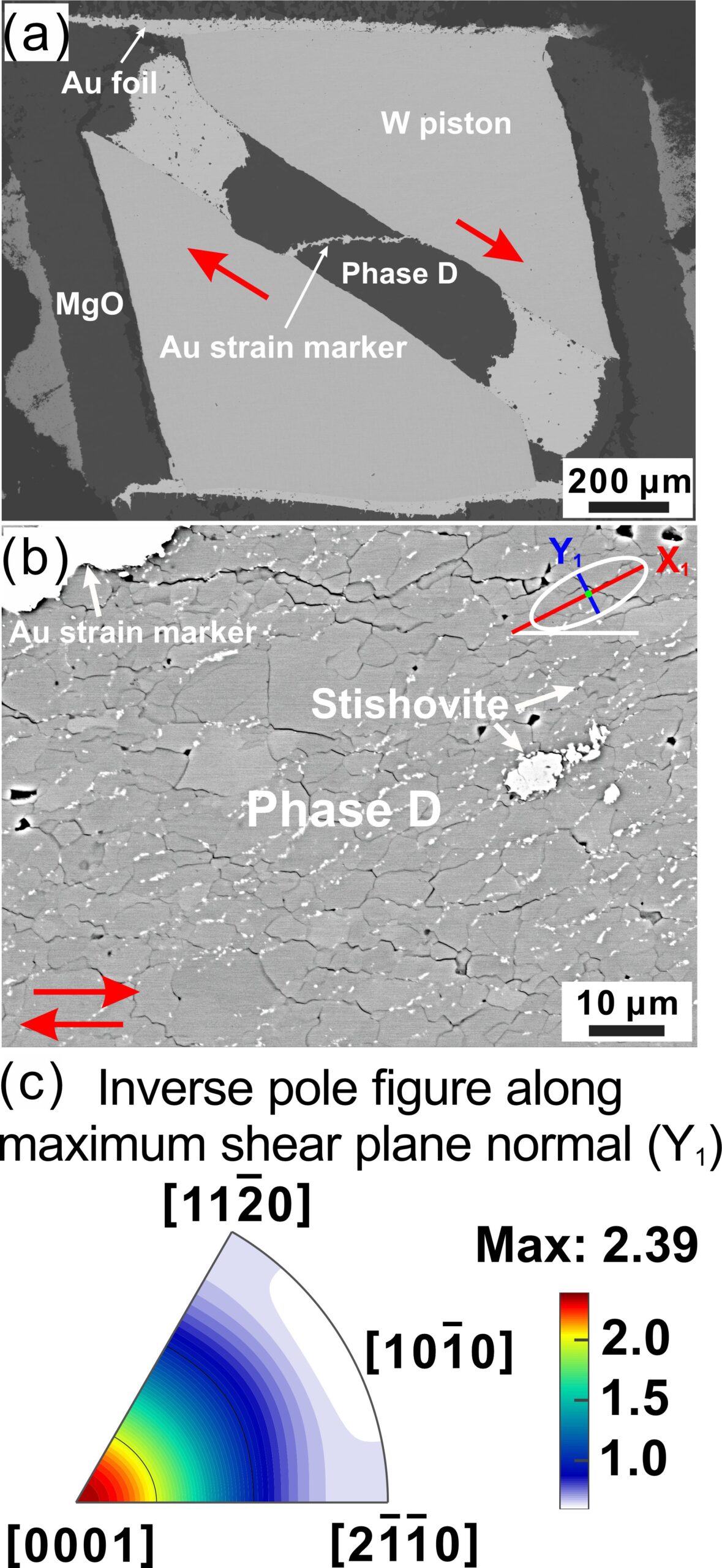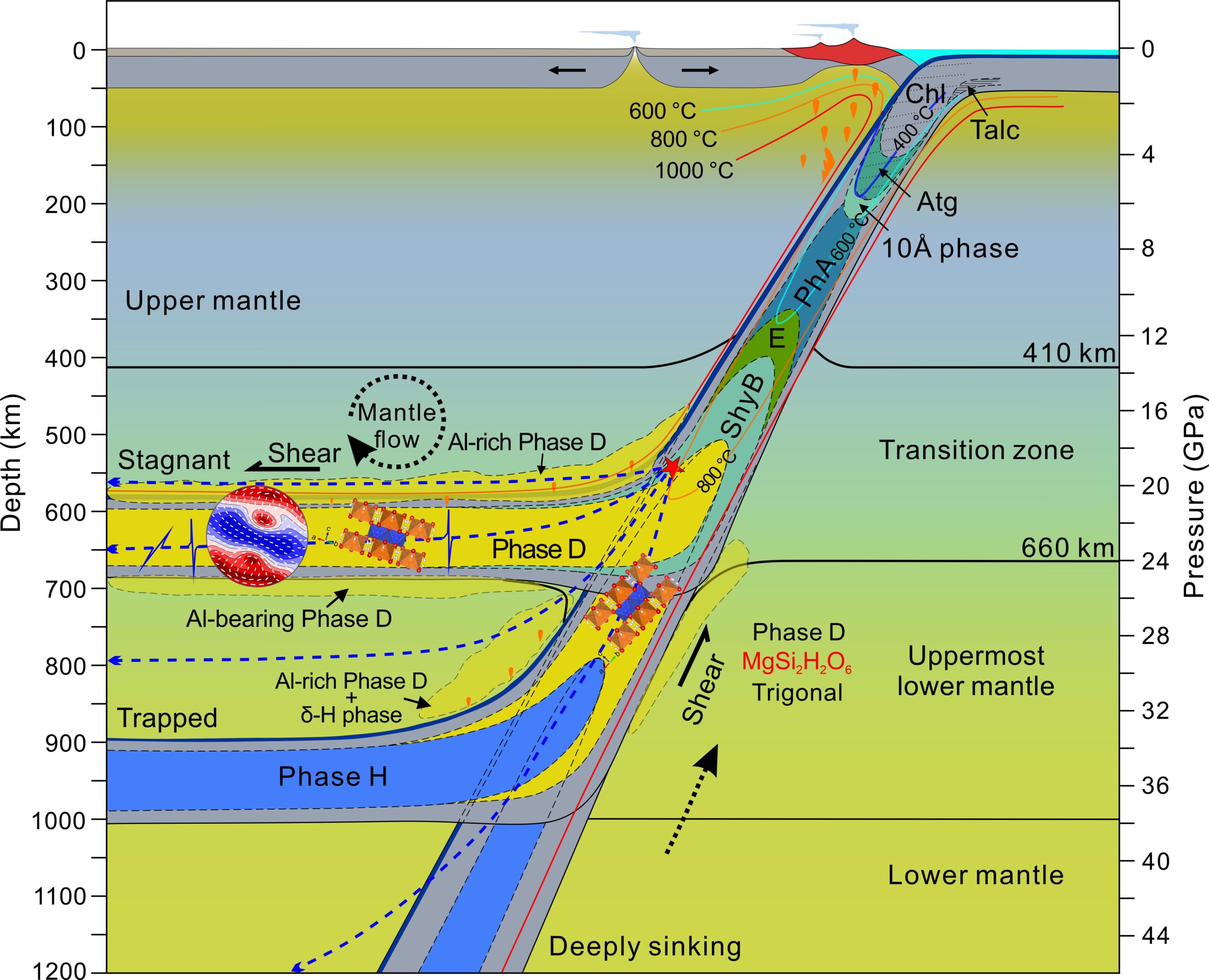Seismic anisotropy in the deep mantle could partly be derived from the deformation of hydrous phase D
Crystallographic preferred orientation of phase D at high pressure and temperature
Well-controlled uniaxial and simple shear deformation experiments were conducted on Mg-endmember phase D and Al-bearing phase D aggregates at 20GPa and 500–1,000°C. Strong (0001) fabrics were observed in both uniaxially compressed and simple shear samples. Our results suggest that the seismic anisotropy observed in the mid-mantle in several cold subduction zones can be attributed to the presence of deformed phase D.
Shear waves split into fast and slow waves when they travel through elastically anisotropic media, and the anisotropy of the seismic velocity is recorded by seismic stations. In the Earth’s deep interior, this is usually interpreted as the effect of crystallographic preferred orientation (CPO) of the constituent minerals. In the uppermost lower mantle, seismic anisotropy is ubiquitous near subducting slabs, where shear waves with horizontal polarization propagate faster than those with vertical polarization (VSH > VSV). Phase D, an elastically anisotropic hydrous mineral, is stable around cold subducting slabs at depths of mid mantle, potentially being the source of seismic anisotropy. To investigate this, we performed well-controlled deformation experiments on phase D aggregates under conditions of the lower mantle transition zone. Our results suggest that phase D tends to predominantly glide in (0001) crystallographic planes, developing significant CPO under high pressure and high temperature conditions. The seismic anisotropy observed in the mid-mantle in several cold subduction zones can be explained by the deformation of phase D.
Reference URL: https://doi.org/10.1029/2024JB029734
Bibliographic Information
Crystallographic Preferred Orientation of Phase D at High Pressure and Temperature: Implications for Seismic Anisotropy in the Mid‐Mantle,
Wentian Wu, Yu Nishihara, and Noriyoshi Tsujino,
Journal of Geophysical Research: Solid Earth, 129, e2024JB029734. 2024 (October 8)
Fundings
- Japan Society for the Promotion of Science (JSPS) under Grant‐in‐Aid for Scientific Research (A) (19H00723, 19H00722) and (B) (24K00738).
Media
-

Microstructure and CPO of shear-deformed Al bearing-phase D.
(a, b) Images show deformation cell assemblage and microstructure of shear-deformed Al bearing-phase D aggregate under 20GPa, 800°C, conditions of lower mantle transition zone. Large deviation of strain marker and elongated grains indicate that significant strain was applied to the sample. (c) The inverse pole figure suggests that the (0001) lattice plane predominantly aligns in the shear plane after deformation.
credit : Wentian Wu, Ehime University
Usage Restriction : Please get copyright permission -

Schematic cross-section illustrating the stability of hydrous phases in cold subducting slabs and the shear-wave anisotropy generated from deformed phase D.
The calculated seismic anisotropy of deformed phase D is consistent with seismological observations in some cold subduction zones in the mid-mantle, where VSH > VSV. Blue dotted lines indicate horizontal or nearly slab-parallel propagation of shear-waves.
credit : Wentian Wu, Ehime University
Usage Restriction : Please get copyright permission
Contact Person
Name : Wentian Wu, Yu Nishihara
Phone : +81-89-927-8150
E-mail : i870008z@mails.cc.ehime-u.ac.jp, nishihara.yu.mc@ehime-u.ac.jp
Affiliation : Geodynamics Research Center, Ehime University

